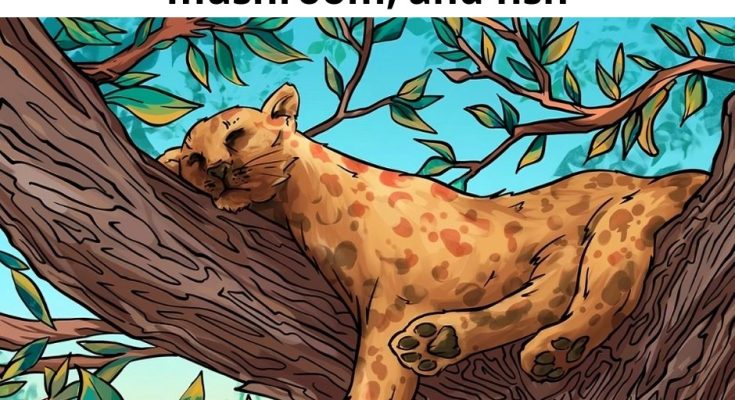Hidden-object puzzles are the perfect way to test your attention to detail and challenge your brain. Today’s puzzle presents a seemingly simple scene — a resting leopard lounging in a tree. But don’t be fooled! This image hides four cleverly concealed items: a banana, a hand, a mushroom, and a fish. At first glance, it may seem like just a peaceful jungle moment, but look a little closer, and you’ll see these hidden gems waiting to be discovered.
Can you spot them all? Take a moment to carefully inspect the image before scrolling down for the solution. If you’re stumped, don’t worry! We’re here to guide you through the process step by step. Let’s dive in!
Why Hidden Details Are So Tricky to Find
Hidden-object puzzles may seem simple at first, but their design can be deceptively difficult. Why do these puzzles tend to trip us up? There are a few key reasons that make these challenges particularly tricky:
Camouflage and Blending In

One of the most common techniques used in these puzzles is camouflage. Artists cleverly blend the hidden objects into the surrounding elements, making them hard to detect. For example, the mushroom could resemble a spot in the leopard’s fur, or the hand might be disguised as part of a tree branch. This seamless blending makes it easy for our brains to miss the subtle clues.
Visual Overload and Our Brain’s Limitations
When we’re confronted with an image full of intricate details, our brains can easily become overwhelmed. We can only process so much information at once, and when there’s a lot happening in the scene, it’s easy to overlook small objects that don’t immediately stand out. It’s like trying to find a needle in a haystack!
Assumptions and Stereotypes
Sometimes, our minds play tricks on us. We make assumptions about where certain items should be placed. For example, if you’re looking for a fish, your mind might automatically expect it to be in water. However, this fish is hidden in an unexpected place — on a tree! These assumptions can cause us to overlook the object when it’s not in the “expected” location.
Focus Blindness: Missing the Forest for the Trees
Our brains are wired to focus on the most prominent elements of an image. In this case, the large and striking leopard in the tree draws our attention. We often zero in on the main subject, ignoring the finer details in the background. This phenomenon is called focus blindness, and it’s one of the reasons hidden objects are so easy to miss.
With these psychological factors in mind, let’s get ready to tackle this puzzle together!
Step-by-Step Guide to Finding the Hidden Items
Ready to start searching? Here’s a detailed, step-by-step guide to help you find the hidden banana, hand, mushroom, and fish. Follow along and sharpen your observation skills!
Finding the Banana
- Hint: Bananas grow on leaves in the jungle, so look carefully around the foliage.
- Solution: The banana is cleverly hidden on the right side of the image, blending with the veins of a large leaf. Its curved shape matches the contours of the leaf, making it difficult to spot at first glance.
Spotting the Hand
- Hint: Hands don’t typically belong in trees, but this one might be disguised as part of a branch.
- Solution: The hand is cleverly camouflaged on the left branch of the tree. The fingers are subtly shaped to resemble small offshoots of the branch, blending in perfectly with the tree’s natural texture.
Identifying the Mushroom
- Hint: The mushroom might not be in the ground where you’d expect. Check the leopard carefully.
- Solution: The mushroom is hidden on the leopard’s body, camouflaged as part of its spotted fur. Upon closer inspection, you’ll notice that the mushroom’s shape resembles a large fur spot, blending seamlessly into the leopard’s coat.
Finding the Fish
- Hint: The fish is not swimming in water but may be carved into the tree bark.
- Solution: The fish is subtly etched into the tree trunk, blending with the lines of the bark. The fish’s outline is faint, so take your time to examine the texture of the tree closely. You’ll see the subtle shape emerge once you focus.
How to Improve Your Observation Skills
If you found yourself struggling to spot some of these hidden objects, don’t worry! These puzzles are meant to challenge you, and with a little practice, you’ll improve in no time. Here are some tips to help you become a master at finding hidden details:
Slow Down and Take Your Time
One of the best ways to improve your observation skills is to slow down and methodically scan the image. Rushing through a puzzle often leads to missing key details, so take a moment to carefully study each part of the scene.
Examine the Whole Picture
Instead of fixating on just one part of the image (like the leopard), take in the entire scene. Hidden objects can be anywhere — even in the background or tucked into smaller, less noticeable areas.
Change Your Perspective
Sometimes, a fresh perspective can make all the difference. Try zooming in or zooming out, or viewing the image from a different angle. A shift in perspective can help reveal things you might have missed initially.
Focus on Shapes and Patterns
Hidden objects often mimic the shapes and patterns in the surrounding environment. Look for things that might blend into the background — a hand that looks like a branch, a fish resembling a knot in the wood, or a mushroom that blends with fur spots. Training your brain to focus on these subtle details will improve your chances of spotting them in the future.
Practice Makes Perfect
Like any skill, practice is key. The more hidden-object puzzles you complete, the sharper your observation skills will become. Keep challenging yourself with more puzzles, and over time, you’ll become an expert at spotting hidden details.
Conclusion
How did you do? Were you able to find all four hidden items — the banana, hand, mushroom, and fish — or did you need a little help? Hidden-object puzzles like this one are an enjoyable way to hone your attention to detail, improve your focus, and train your brain. They can also be a fun way to spend time and challenge yourself.
Remember, the more you practice, the better you’ll become at recognizing the small details that others might miss. Hidden-object puzzles aren’t just about having fun — they’re also about sharpening your observation skills and improving your ability to focus on the finer details of life.
If you enjoyed this puzzle, be sure to try more challenges to keep your mind sharp and your observation skills on point. Every time you uncover a hidden object, you’re taking one step closer to mastering the art of seeing what others overlook. Happy puzzling!



